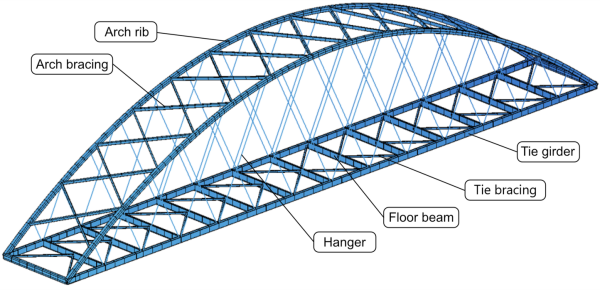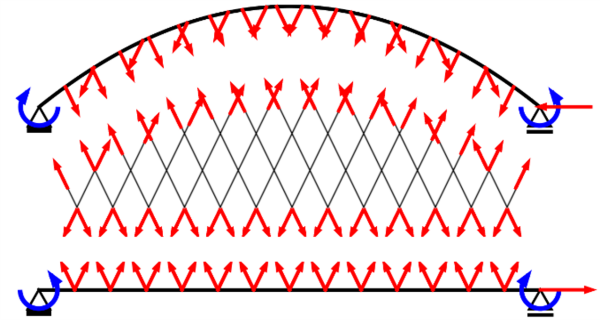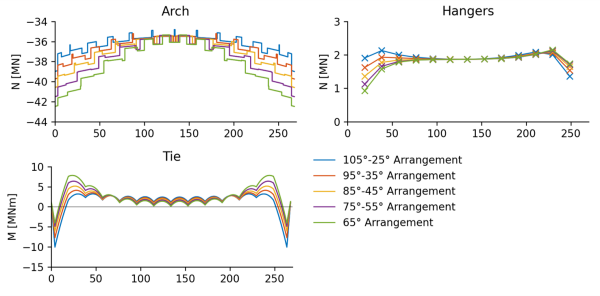Optimisation of Network Tied-Arch Bridges
Arch Shape, Network Pattern and Density
Author: Urias Morf
Language: English
Abstract
The efficient design of a network tied-arch bridge is a particular challenge due to its many design variables, such as the arch shape, the hanger arrangement and the deck system. In the last two decades, it has become a popular alternative for medium spans for road and railway bridges. Considering its efficient use of materials, a further increase of its usage is desirable. However, many aspects have not been considered in an integral approach and sufficient depth. Understanding the influence of the key design variables on the structural behaviour provides the basis to give general guidelines for obtaining a fast and simple initial design. Therefore, different hanger arrangement patterns have been developed, which have to be verified in the classical strength limit states for vehicular use and wind exposure, but also multiple extreme events and fatigue. This study aims to investigate the hanger density and its inclination further. Therefore, suitable methods for the derivation of the arch shape and the self-equilibrium stress state are necessary. In this context, the self-equilibrium stress state describes the locked-in erection stresses indirectly by the permanent supernumerary forces.
By investigating the Blennerhassett Island Bridge, optimisation potential for the hanger density and the hanger inclination is identified. Further, new methodologies for the derivation of the arch shape and the self-equilibrium stress state are introduced. For the arch shape, an approximation of the thrust line of the hypothetical continuous hanger arrangement is recommended. The self-equilibrium stress state is optimised by formulating an efficiently solvable linear programming problem. The investigation is conducted in a linear elastic single arch plane model under various strength and extreme event limit states. As a measure for the optimality, the main components' structural costs are estimated for comparative purposes. For the reference case of the Blennerhassett Island Bridge, the approximation of the arch shape to the thrust line and an optimised self-equilibrium stress state yielded considerable savings. On the other hand, the hanger density has a negligible impact on the structural behaviour besides reducing the effects in the extreme event of cable loss. Ultimately, the hanger inclination significantly changes the elastic response of the structure and the optimal arch shape.
Based on the results, new design guidelines are formulated. Primarily, the floating deck should be optimised in a first step before considering the structure of the network arch. The considerable offset of the arch's thrust line to the typical arch shapes under permanent loads is reduced by adapting the shape to the respective quartic polynomial. Further, a uniform spacing of the hanger anchorages on the arch rib is recommended to reduce the inevitable shape deviation moments. However, a uniform spacing on the tie girder is also critical, rendering the radial hanger arrangement particularly disadvantageous. An increased hanger density has to be paired with a corresponding increase in the number of floor beams. Ultimately, the constant change of inclination arrangement considerably increased the coupling of the arch rib and the tie girder. Therefore, it is a recommended arrangement in particular with substantial changes in the hangers' inclinations. These guidelines are particular to the Blennerhassett Island Bridge and its particularly large spacing of the hangers and the floor beams. Further investigations of smaller bridges and composite deck systems can be conducted using the same methods and could provide promising insights.



